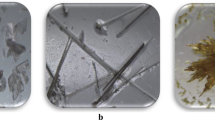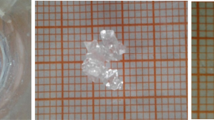Abstract
The inclusion of 1,8-octanediphosphonic acid (OA) in cucurbit[7]uril (Q[7]) has been investigated via a combined solid state and solution study. The reaction of OA and Q[7] in water led to the formation of a 1:1 inclusion compound 1 as a white crystalline material. Synchrotron single crystal X-ray diffraction revealed its detailed structure validated by Raman spectroscopy with featured vibrational modes from both organic molecules. Subsequent 1H solution NMR data supported the formation of a 1:1 inclusion complex in aqueous solution. The changes in NMR chemical shifts are consistent with the solid-state orientation in which the phosphonic acid groups of OA are oriented externally to the carbonyl portals and the intervening alkyl chain lies within the cavity of Q[7]. However, the solution study also inferred possible formations of other complexes in solution. This work highlighted the advantage of combining solid state and solution studies to reveal the detailed molecular interactions involving complex inclusion phenomena.
Graphical abstract








Similar content being viewed by others
References
Kim, J., Jung, I.-S., Kim, S.-Y., Lee, E., Kang, J.-K., Sakamoto, S., Yamaguchi, K., Kim, K.: New cucurbituril homologues: Syntheses, isolation, characterization, and X-ray crystal structures of cucurbit[n]uril (n = 5, 7, and 8). J. Am. Chem. Soc. 122, 540–541 (2000). https://doi.org/10.1021/ja993376p
Liu, S., Zavalij, P.Y., Isaacs, L.: Cucurbit[10]uril. J. Am. Chem. Soc. 127, 16798–16799 (2005). https://doi.org/10.1021/ja056287n
Assaf, K.I., Nau, W.M.: Cucurbiturils: From synthesis to high-affinity binding and catalysis. Chem. Soc. Rev. 44, 394–418 (2015). https://doi.org/10.1039/C4CS00273C
Lee, J.W., Samal, S., Selvapalam, N., Kim, H.-J., Kim, K.: Cucurbituril homologues and derivatives: New opportunities in supramolecular chemistry. Acc. Chem. Res. 36, 621–630 (2003). https://doi.org/10.1021/ar020254k
Kim, K., Selvapalam, N., Ko, Y.H., Park, K.M., Kim, D., Kim, J.: Functionalized cucurbiturils and their applications. Chem. Soc. Rev. 36, 267–279 (2007). https://doi.org/10.1039/B603088M
Wyman, I.W., Macartney, D.H.: Cucurbit[7]uril host–guest complexes with small polar organic guests in aqueous solution. Org. Biomol. Chem. 6, 1796–1801 (2008). https://doi.org/10.1039/B801650J
Jeon, W.S., Moon, K., Park, S.H., Chun, H., Ko, Y.H., Lee, J.Y., Lee, E.S., Samal, S., Selvapalam, N., Rekharsky, M.V., Sindelar, V., Sobransingh, D., Inoue, Y., Kaifer, A.E., Kim, K.: Complexation of ferrocene derivatives by the cucurbit[7]uril host: A comparative study of the cucurbituril and cyclodextrin host families. J. Am. Chem. Soc. 127, 12984–12989 (2005). https://doi.org/10.1021/ja052912c
Freeman, W.A., Mock, W.L., Shih, N.-Y.: Cucurbituril J. Am. Chem. Soc. 103, 7367–7368 (1981). https://doi.org/10.1021/ja00414a070
Barrow, S.J., Kasera, S., Rowland, M.J., del Barrio, J., Scherman, O.A.: Cucurbituril-based molecular recognition. Chem. Rev. 115, 12320–12406 (2015). https://doi.org/10.1021/acs.chemrev.5b00341
Walker, S., Oun, R., McInnes, F.J., Wheate, N.J.: The potential of cucurbit[n]urils in drug delivery. Isr. J. Chem. 51, 616–624 (2011). https://doi.org/10.1002/ijch.201100033
Wheate, N.J., Buck, D.P., Day, A.I., Collins, J.G.: Cucurbit[n]uril binding of platinum anticancer complexes. Dalton Trans. 451–458 (2006). https://doi.org/10.1039/B513197A
Kuok, K.I., Li, S., Wyman, I.W., Wang, R.: Cucurbit[7]uril: An emerging candidate for pharmaceutical excipients. Ann. N Y Acad. Sci. 1398, 108–119 (2017). https://doi.org/10.1111/nyas.13376
Virovets, A.V., Blatov, V.A., Shevchenko, A.P.: Methods of crystallochemical analysis of supramolecular complexes by means of Voronoi-Dirichlet polyhedra: A study of cucurbituril host-guest compounds. Acta Crystallogr. Sect. B. 60, 350–357 (2004). https://doi.org/10.1107/S0108768104005051
Florea, M., Nau, W.M.: Strong binding of hydrocarbons to cucurbituril probed by fluorescent dye displacement: A supramolecular gas-sensing ensemble. Angew Chem. Int. Ed. 50, 9338–9342 (2011). https://doi.org/10.1002/anie.201104119
Zhang, S., Grimm, L., Miskolczy, Z., Biczók, L., Biedermann, F., Nau, W.M.: Binding affinities of cucurbit[n]urils with cations. Chem. Commun. 55, 14131–14134 (2019). https://doi.org/10.1039/C9CC07687E
Ni, X.-L., Xiao, X., Cong, H., Liang, L.-L., Cheng, K., Cheng, X.-J., Ji, N.-N., Zhu, Q.-J., Xue, S.-F., Tao, Z.: Cucurbit[n]uril-based coordination chemistry: From simple coordination complexes to novel poly-dimensional coordination polymers. Chem. Soc. Rev. 42, 9480–9508 (2013). https://doi.org/10.1039/C3CS60261C
Cao, L., Šekutor, M., Zavalij, P.Y., Mlinarić-Majerski, K., Glaser, R., Isaacs, L.: Cucurbit[7]uril⋅guest pair with an attomolar dissociation constant. Angew Chem. Int. Ed. 53, 988–993 (2014). https://doi.org/10.1002/anie.201309635
Nau, W.M., Florea, M., Assaf, K.I.: Deep inside cucurbiturils: Physical properties and volumes of their inner cavity determine the hydrophobic driving force for host–guest complexation. Isr. J. Chem. 51, 559–577 (2011). https://doi.org/10.1002/ijch.201100044
Li, J.-R., Sculley, J., Zhou, H.-C.: Metal–organic frameworks for separations. Chem. Rev. 112, 869–932 (2012). https://doi.org/10.1021/cr200190s
Bulut, A., Zorlu, Y., Topkaya, R., Aktaş, B., Doğan, S., Kurt, H., Yücesan, G.: Macrocyclic Cu(II)-organophosphonate building block with room temperature magnetic ordering. Dalton Trans. 44, 12526–12529 (2015). https://doi.org/10.1039/C5DT01596K
Bulut, A., Maares, M., Atak, K., Zorlu, Y., Çoşut, B., Zubieta, J., Beckmann, J., Haase, H., Yücesan, G.: Mimicking cellular phospholipid bilayer packing creates predictable crystalline molecular metal–organophosphonate macrocycles and cages. CrystEngComm. 20, 2152–2158 (2018). https://doi.org/10.1039/C8CE00072G
Gagnon, K.J., Perry, H.P., Clearfield, A.: Conventional and unconventional metal–organic frameworks based on phosphonate ligands: MOFs and UMOFs. Chem. Rev. 112, 1034–1054 (2012). https://doi.org/10.1021/cr2002257
Yu, Z.-C., Lu, Y., Shan, P.-H., Fan, Y., Tao, Z., Xiao, X., Wei, G., Prior, T.J., Redshaw, C.: A study of the inclusion complex formed between cucurbit[8]uril and isonicotinic acid. J. Incl. Phenom. Macrocycl. Chem. 102, 619–628 (2022). https://doi.org/10.1007/s10847-022-01141-6
Gao, Z.-Z., Kan, J., Tao, Z., Bian, B., Xiao, X.: A stimuli-responsive supramolecular assembly between inverted cucurbit[7]uril and hemicyanine dye. New. J. Chem. 42, 15420–15426 (2018). https://doi.org/10.1039/C8NJ03344G
Zhang, Y., Liu, M., Karatchevtseva, I., Price, J.R., Tao, Z., Wei, G.: Yttrium and lanthanide (ln = La and Gd) complexes with cucurbit[10]uril: Crystals transforming from supramolecular networks to coordination nanotubes. New. J. Chem. 44, 18208–18215 (2020). https://doi.org/10.1039/D0NJ03962D
Yao, Y.-Q., Zhang, Y.-J., Huang, C., Zhu, Q.-J., Tao, Z., Ni, X.-L., Wei, G.: Cucurbit[10]uril-based smart supramolecular organic frameworks in selective isolation of metal cations. Chem. Mater. 29, 5468–5472 (2017). https://doi.org/10.1021/acs.chemmater.7b01751
Zhang, Y., Panjikar, S., Chen, K., Karatchevtseva, I., Tao, Z., Wei, G.: Lanthanoid heteroleptic complexes with cucurbit[5]uril and dicarboxylate ligands: From discrete structures to one-dimensional and two-dimensional polymers. Inorg. Chem. 58, 506–515 (2019). https://doi.org/10.1021/acs.inorgchem.8b02732
Zhang, Y., Karatchevtseva, I., Liu, M., Tao, Z., Wei, G.: Thorium(IV) and uranium(IV) complexes with cucurbit[8]uril: Supramolecular structures via direct coordination and second-shell interactions. Polyhedron. 192, 114826 (2020). https://doi.org/10.1016/j.poly.2020.114826
Xu, W., Liu, M., Escaño, M.C., Redshaw, C., Bian, B., Fan, Y., Tao, Z., Xiao, X.: Alkyl substituted 4-pyrrolidinopyridinium salts encapsulated in the cavity of cucurbit[10]uril. New. J. Chem. 43, 7028–7034 (2019). https://doi.org/10.1039/C9NJ01089K
Mock, W.L., Shih, N.-Y.: Structure and selectivity in host-guest complexes of cucurbituril. J. Org. Chem. 51, 4440–4446 (1986). https://doi.org/10.1021/jo00373a018
Biedermann, F., Uzunova, V.D., Scherman, O.A., Nau, W.M., De Simone, A.: Release of high-energy water as an essential driving force for the high-affinity binding of cucurbit[n]urils. J. Am. Chem. Soc. 134, 15318–15323 (2012). https://doi.org/10.1021/ja303309e
van Megen, M., Frank, W., Reiss, G.J.: A detailed comparative structural study of the hydrogen bonded networks in solids, obtained by the reaction of 4,4′-bipyridine and varied alkane-α,ω-diphosphonic acids. CrystEngComm. 18, 3574–3584 (2016). https://doi.org/10.1039/C5CE02156A
Aragão, D., Aishima, J., Cherukuvada, H., Clarken, R., Clift, M., Cowieson, N.P., Ericsson, D.J., Gee, C.L., Macedo, S., Mudie, N., Panjikar, S., Price, J.R., Riboldi-Tunnicliffe, A., Rostan, R., Williamson, R., Caradoc-Davies, T.T.: MX2: A high-flux undulator microfocus beamline serving both the chemical and macromolecular crystallography communities at the Australian Synchrotron. J. Synchrotron Rad. 25, 885–891 (2018). https://doi.org/10.1107/S1600577518003120
Kabsch, W.: Integration, scaling, space-group assignment and post-refinement. Acta Crystallogr. Sect. D. 66, 133–144 (2010). https://doi.org/10.1107/S0907444909047374
Sheldrick, G.M.: SADABS, Empirical Absorption and Correction Software. University of Göttingen, Göttingen (1996)
Sheldrick, G.M.: SHELXT - integrated space-group and crystal-structure determination. Acta Crystallogr. Sect. A. 71, 3–8 (2015). https://doi.org/10.1107/S2053273314026370
Sheldrick, G.M.: Crystal structure refinement with SHELXL. Acta Crystallogr. Sect. C. 71, 3–8 (2015). https://doi.org/10.1107/S2053229614024218
Dolomanov, O.V., Bourhis, L.J., Gildea, R.J., Howard, J.A.K., Puschmann, H.: OLEX2: A complete structure solution, refinement and analysis program. J. Appl. Cryst. 42, 339–341 (2009). https://doi.org/10.1107/S0021889808042726
Acknowledgements
Synthesis and characterization of materials were carried out in the facilities under Nuclear Science and Technology (NST) at ANSTO. The crystallographic data for compound 1 were collected on the MX2 beamline at the Australian Synchrotron, a part of ANSTO, and made use of the Australian Cancer Research Foundation (ACRF) detector.
Author information
Authors and Affiliations
Contributions
M.C. performed synthesis and solution NMR; I.K. did Raman measurement; A. A. performed NOESY NMR experiment; Y.Z. collected single crystal data and did structure refinement; all authors contributed to the paper writing and editing.
Corresponding author
Ethics declarations
Competing interests
The authors declare no competing interests.
Additional information
Publisher’s Note
Springer Nature remains neutral with regard to jurisdictional claims in published maps and institutional affiliations.
Electronic supplementary material
Below is the link to the electronic supplementary material.
Rights and permissions
About this article
Cite this article
Cagnes, M., Karatchevtseva, I., Angeloski, A. et al. Inclusion of 1,8-octanediphosphonic acid in cucurbit[7]uril: a combined solid state and solution study. J Incl Phenom Macrocycl Chem 104, 149–159 (2024). https://doi.org/10.1007/s10847-024-01227-3
Received:
Accepted:
Published:
Issue Date:
DOI: https://doi.org/10.1007/s10847-024-01227-3




